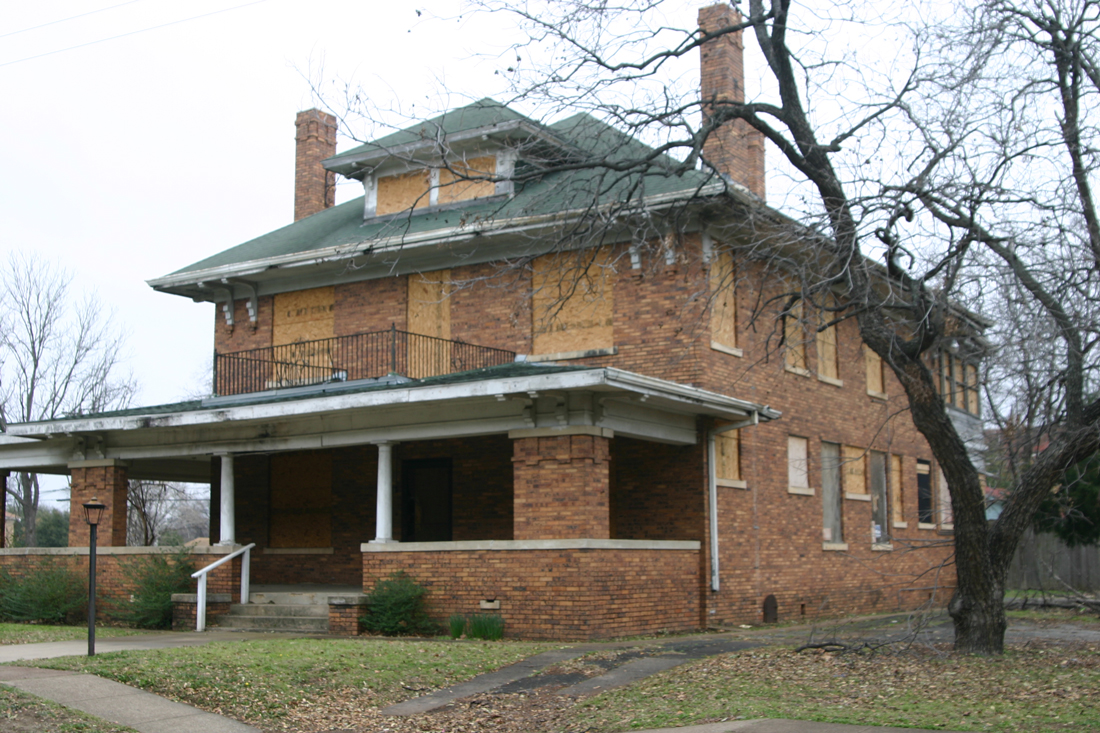Historic Fort Worth Inc. filed a lawsuit after the city paved the way for demolition of a historic house, and the suit was set to determine whether the preservation ordinance has teeth.
Hmmm. Maybe it should be called the Gummy Ordinance.
A state district judge’s ruling on Friday could allow owners of historically designated properties to sidestep the city’s preservation rule, Historic and Cultural Landmarks Commission, and the Appeals Board. Instead they can seek relief through the Planning and Zoning Commission.
“If you can bypass the Landmarks Commission, nobody is going to seek to do it anymore,” said attorney Art Brender, who is representing Historic Fort Worth in the lawsuit.
Texas Wesleyan University owns the historic S.S. Dillow house that was built in 1912 in southeast Fort Worth, across the street from the campus on East Rosedale. Dillow was a grocer, banker, and community volunteer in the Polytechnic Heights area. After his death in 1931, his daughter, Aubrey, lived in the home until her death in 1982. She donated the house to the college, and TWU renovated the property, received a historic and cultural landmark designation, and used the building for various purposes for 25 years.
TWU vacated the house in 2007, and the past five years haven’t been kind. Two fires, various vandalisms, and a lack of regular maintenance have left the house boarded up and decaying.
The university doesn’t have the money to repair the house, can’t find donors, and hasn’t been able to sell the property, TWU spokesman John Veilleux said.
“There is no doubt that the Dillow family and the house over the years have been very influential on this part of the city,” he said. “Given the recent history, the fires in the building, the general state that it’s in, we believe it has lost its historical significance and needs to be razed.”
The school applied to have the historic designation removed last summer, citing two claims –– the house had lost historic significance, and renovations would cause the school economic hardship. Renovation costs are estimated at $800,000.
The Landmarks Commission denied the application, saying the school hadn’t proved either claim. TWU appealed the decision. But the case never made it to the Appeals Board. Instead, TWU dropped its appeal and tried a new tack. The school asked the Zoning Commission to remove the historic designation.
In January the Zoning Commission recommended that the designation be removed. The next month, city council members agreed in a 6-2 vote. City council member Kelly Allen Gray, who represents the Poly area, voted to let TWU rid itself of the designation, saying the neighborhood could use new development.
TWU was suddenly free to apply for a demolition permit, although it hasn’t done so yet. Historic Fort Worth members cried foul.
“We think the ordinance was not upheld by the city,” said John Roberts, chairman of Historic Fort Worth Inc.
In the past, the Historic Preservation Overlay District ordinance required property owners to appear before the Landmarks Commission when attempting to remove a historic designation. The city council appoints commission members.
“The city of Fort Worth has an excellent preservation ordinance that many cities would like to have, and it is important for the city council to uphold the preservation ordinance for local landmark buildings,” Roberts said.
However, some of the ordinance’s language was omitted during a 2007 revision. The ordinance no longer requires a separate Landmarks Commission vote when property owners seek to remove historic designations.
A city employee was unsure why the language was left out and said the city staffer who oversaw the ordinance revision in 2007 no longer works for the city. Due to litigation, however, city officials are not discussing the matter.
Burns has asked staff to change the ordinance back to the way it was. (He did not respond to Fort Worth Weekly’s phone calls seeking comment for this article.)
TWU’s end-around maneuver caught Historic Fort Worth off-guard. The nonprofit group didn’t know about the ordinance’s being watered down and didn’t think they were getting clear answers from city staff. The group blamed city officials and sought a legal injunction to prevent setting aside the historic designation.
During Friday’s hearing, assistant city attorney Christopher Mosley told the judge that Historic Fort Worth lacked standing to bring the lawsuit. The group has no ownership in the property and suffered no injury, he argued, and should have included TWU in its suit.
Historic Fort Worth must now decide whether to sue the university. School officials say that’s unnecessary.
“Texas Wesleyan simply sought the natural relief it was entitled to under the current city ordinance,” Veilleux said. “The historical society can choose to sue us, too, but they don’t have to. They could choose to drop the case. We think it is poor precedent for the historical society to sue us, or any other nonprofit public or private entity, for pursuing relief under a standing city ordinance. ”
The Dillow house, like the university, is surrounded by blue-collar businesses and single-family homes, duplexes, and rental properties, some of which don’t look much better than the Dillow house. An informal door-to-door survey of nearby property owners revealed little outrage over the proposed demolition. Most knew nothing about the historic house or the school’s plans to raze it. Few seemed to care.
Jo Turner, however, has lived across the street from TWU for 35 years, and she said the Dillow House should be preserved because “it’s historical.”
Preservationists feel the same way. Some have written disparaging comments on local websites accusing TWU of “demolition by neglect.” Others wonder if the school inflated renovation costs to justify its claims of economic hardship.
Those accusations are offensive and untrue, Veilleux said.
“We don’t behave in that manner,” he said. “That would be highly unethical. That was an old building, and over time it deteriorated. ”
Innovative Developers Inc. (IDI) provided the estimate for renovation.
“Folks questioned our bid, but the reality is, the folks who said it doesn’t cost that much haven’t been in the building and haven’t seen the damage,” Veilleux said.
The president and CEO of IDI is Glen Hahn, who is also a TWU board member. Veilleux does not consider that a conflict of interest. It’s common for nonprofit entities to accept free services, he said.
“Those services happened to be from a board member who has expertise in this area, so we accepted that donation,” he said. “I call that responsible stewardship of the tuition dollars we receive to operate the university.”
TWU did not award a contract to IDI to do the renovation, he said.
The school wants to enlarge its campus and transform the Dillow House property into a new entranceway. Even Historic Fort Worth recognizes the strides taken by the school to revitalize the neighborhood and to care for other historic structures on its campus.
“That’s kind of why this is a tough case,” Roberts said. “They have shown they are preservation-friendly, but in this case they’ve decided to tear down the house, and that’s sort of out of character for the university.”













$800,000!!!
Yeah I don’t see it costing $800,000…
I think we should have MORE historically-designated and untouchable eyesores and death-traps in town; doesn’t everybody?
On the other hand, it doesn’t seem quite proper that anyone should be able to seek and obtain an historical designation when it suits their purposes, and then allow the designated property to fall quickly into disrepair and decay so that it can no longer be economically maintained and have no choice but to be destroyed when it NO LONGER suits their purposes.
Absent a requirement that properties that apply for such designation be provided for well into the future (e.g., 50 years?), and somehow be estopped from falling into decay, what other choice is there but to allow it to be removed?
This property is far from the only “historical” property to be in similar straits. While maintaining truly historical properties is a desirable goal, not allowing them to be removed simply by dint of the designation is quite silly.